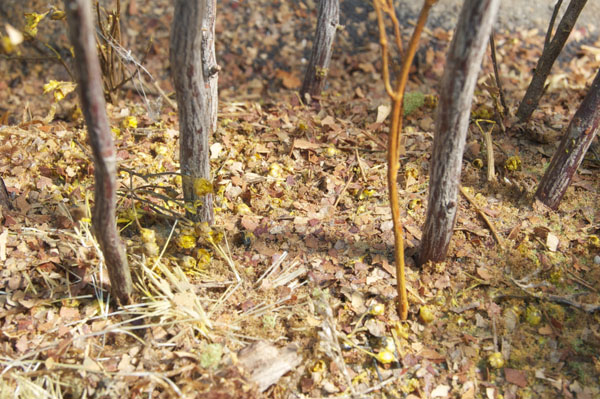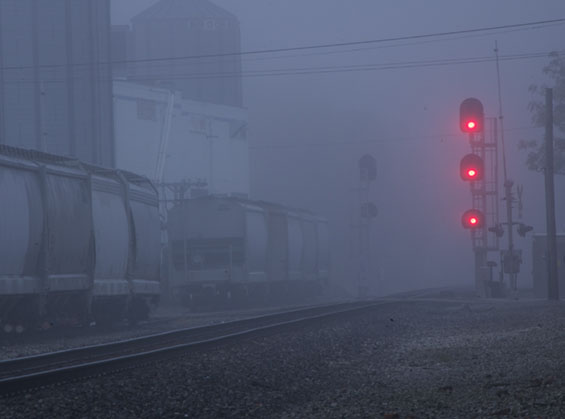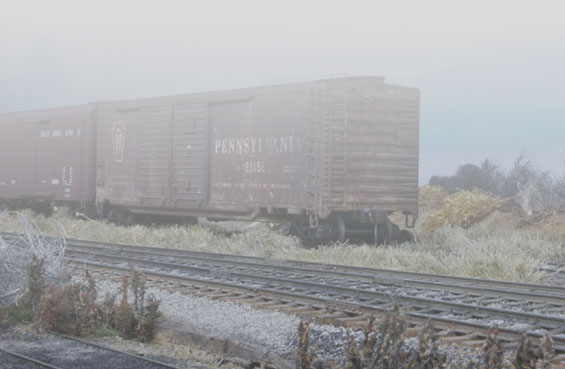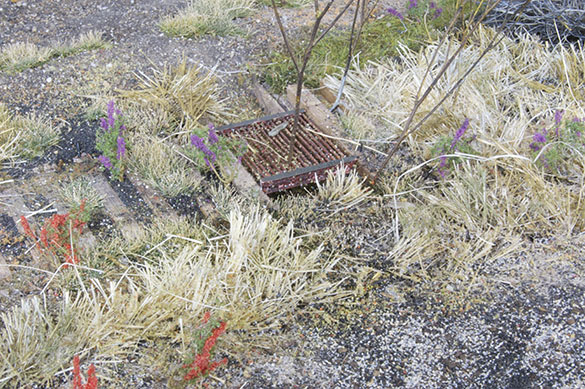Can railroad modeling truly embody the power of a place?
In our pursuit of this craft, we are drawn to certain places. I need only mention locations like Altoona, Essex Junction, Grand Central Terminal, Wiscasset, Leadville or Soldier Summit, to evoke a powerful image.
What about places we’ve never experienced firsthand, how do we connect with a location we’ve never been to? I will never experience Altoona at the height of steam operations, except through vintage photos or by reading firsthand accounts of those who lived in that time and place. As a modeler, my understanding is many times removed from their reality.
The Power Of Place
What draws us to the subjects and places we model? For our purposes, it’s usually the railroad activity each represents. But in our modeling, we focus solely on the trains and their movement against a static background. On a layout the train clears the crossing. The lights stop flashing and the gates rise but those autos sitting there aren’t going to cross the tracks. The family on the nearby front porch will never go in the house, nor play in the yard. The landscape won’t change with the seasons. The power of a living landscape is missing.
 We accept that our models are poor and lifeless facsimiles of reality but how much of our experience of full-size railroading is influenced by the intangible qualities of time, season and weather? We can model fallen leaves but do falling leaves or the damp chill of fog-laden air add to our memories of a scene? Does the absence of these elements alter the experiences we seek to recreate in model form?
We accept that our models are poor and lifeless facsimiles of reality but how much of our experience of full-size railroading is influenced by the intangible qualities of time, season and weather? We can model fallen leaves but do falling leaves or the damp chill of fog-laden air add to our memories of a scene? Does the absence of these elements alter the experiences we seek to recreate in model form?
There’s More Than Trains
On his blog Chris Mears posted a video of a Claremont and Concord switch job going about its business. Beyond the train, here’s a portion of what I saw and heard:
- Foreground weeds and saplings blown by the wind.
- A dump truck preparing to drop his load.
- Reflections of the train in a water puddle.
- Reflections of trees in the cab window as the engine moved to and fro.
- The brakeman throwing a switch then walking out of the scene.
- Highway traffic on an overpass in the background.
- The same dump truck leaving the plant.
- The sound of wind gusts picked up by the camera mic.
- People speaking off camera.
- The way the diesel exhaust is blown by the wind.
And these are only what caught my eye. I probably missed twice that number of events because my field of vision was dictated by the camera. We take such activity for granted. It sits in the background of our attention and since we are hard pressed to convincingly reproduce it in miniature, we ignore these aspects in favor of the trains. I ask though, what does this audio landscape and movement add to your experience of that time and place?
Motion Can Be Implied
You don’t need to see the source of a sound to understand the action. I live within earshot of the Norfolk Southern line that runs through town. I can’t see the trains but I can understand what’s happening from the sound.
Onboard sound is a given for many people now and the quality has improved greatly with modern technology but, locomotive sound is the easy part. The landscape of ambient sound that lives in the background of our attention is much harder to duplicate. It requires a thorough understanding of the nuances of sound in the real world. Something most of us are totally ignorant of. In most cases, no sound is better than poorly executed noise.
Yet, when it’s done with care and understanding ambient sounds can transport us to a place with an uncanny degree of realism. If modelers can identify differences in the rivet pattern between two boxcars, we can educate ourselves about ambient sound patterns. The question is, how many will do so? But this is not a post about sound. Sound is just one aspect of the landscape. There is also light, which is a topic in itself.
Can we model the intangible?
We can, if we learn to think holistically.
In modeling, we give scant notice to how the railroad and community grew together. We only give a cursory acknowledgement of how the railroad fits the landscape and in turn, is shaped by it. Last year I realized much of the frustration I felt toward my layout was because it was overcrowded with track. In quarter-inch scale, overcrowding is an easy trap to fall into. I removed two turnouts and two tracks on one end and a difficult to reach track on the other, giving both scenes much needed breathing room. The intangible benefit from the open space far outweighed the loss of track that wasn’t serving a critical role. Near the mill, I left the empty, weed choked ties of the mill track in place. I also left visual clues of a swath of right of way for a track that used to be there but now isn’t. Both scenes now provide a stronger image of the railroad in the landscape rather than dominating it as before. The context of Sycamore as a lonely junction that has seen better days is greatly strengthened.
It All Comes Back To Storytelling
Understanding the power of place and how to model it adds a layer of depth to our layout story. As Allen McClelland envisioned the V&O as a link in the national railroad system, that concept became the through line he applied to every aspect of his layout. Each time I visited the V&O, locations like Clintwood took on more of the character of an actual place as Allen refined and strengthened his vision.
In this series of posts, I’ve encouraged you to become students of the landscape. The principles from the fine arts I’ve shared are all based on learning to observe more carefully. Storytelling is the art of conveying an experience beyond the dry facts of a report. Understanding the craft of storytelling enables us to share our experience with power and depth. I understand these are foreign, even strange ideas for many conditioned to the old school ways. We struggle with them because we believe the only stories worth telling revolve around the trains. But the hobby has always grown when people expand their concept of what it can be. What story do you want to tell?
Links:
Video, Chris Mears’ Blog, Seven Minutes Fifty Three Seconds
Trevor Marshall’s Blog, Bird Song: (aka Effective Audio) Layout Sound
Regards,
Mike



Mike,
You might find this interesting. I’m ashamed to say that despite being of huguenot stock and working in London most of my life I’ve never visited it myself http://www.dennissevershouse.co.uk/the-tour/
I’ve always found the concept fascinating though: the mixture of storytelling built around a place and brought to life by hints of habitation. Pendon obviously needs a mention here as well. The Vale Scene isn’t really a model railway at all http://www.pendonmuseum.com/about/vale
James
You might find this [url=”http://www.rmweb.co.uk/community/index.php?/topic/18108-radio-controlled-road-vehicle-and-powered-gantry-crane/”]thread on RMWeb interesting[/url], as it includes a radio controlled road vehicle.
Whether this helps create a sense of place, I’m not sure: there are plenty of ways of simulating the loading and unloading of aggregates!
Personally, I incline to having vehicles parked, and few visible figures – an open doorway can suggest at human activity. Any figures that do appear need to appear relaxed – a couple of workers chewing the fat, for example. The right selection can help set the locale: a group of New York city lawyers in 21st century suits will look out of pace in 1950s Georgia, for example.
I suppose what I am saying is that it can start with the avoidance of obvious anachronisms, and then move into a deeper study of local history, geography, etc. Total immersion in the subject is where this leads.
Simon
James,
The Pendon scene is modeling on a scale I can’t grasp. Wow. Rarely do we get to see a model in such context.
The Severs House looks like a fascinating experience. Very immersive I would imagine. There are abundant lessons we could learn from both examples. Thanks for sharing them.
Regards,
Mike
Hi Mike
I’ve been reading and re-reading this post. It’s fast becoming a personal favourite.
I think it’s funny how we associate places and things. You say Altoona and I think Pennsyvania Railroad. I think steam. I don’t just think steam but big steam. I think of the kinds of trains that we equally equate with the models Lionel sold. I don’t really know anything about Altoona but I do know it belongs to the Pennsylvania Railroad and that feels like the only thing I need to know. Taken literally the power here is, for me, that instant association made between the trains and the town. For me, I have a similar association ingrained in my mind for Farmington, Crewe, and even Montreal. This is the power of a railroad that understood its brand.
I believe that great railroads like the Pennsylvania, the Great Western, or Union Pacific understood the power of their brand on the imaginations of the people they touched. I don’t think it’s any different than a Jimi Hendrix concert or even a trip to Starbucks. The (name) knew what their show was all about. Each masterfully manipulates the “place” to provide context for the perfect experience. They exude an influence on the place that envelopes the audience. There is a realopportunity here to treat the railroad separate to its environment. It is easy to see how we could bring that disconnect home to our model railways.
Perhaps our challenge is to maintain and develop the scene in a way that communicates a cognisense of this inter-relationship? Even if we’re modelling in the current time our railroad wasn’t always there. It was built by the people near. In the years since it was opened it has affected their lives whether they realise it or not. Even today, that railway continues to live in their lives. We see evidence in the Claremont-Concord Railroad video. That dump truck isn’t also in the scene, it is an actor like the train. The scene effectively communicates its story to us in the space between the trainand the truck…the way they have found a way to co-exist.
That’s what makes the scene at West Lebanon as powerful for me as I’m sure Cheyenne or Altoona is for others. Sure I really like trains and the style of railroading and could live on that thrill forever. What really speaks to me, that power, is that even in that short video we see how once rivals (truck v. train) have found a common ground where each can succesfully co-exist to each other’s benefit and showcasing each’s strengths. West Lebanon is a success story for this reason.
We discover the story and in it feel the affect it has on us. We can immerse ourselves in wonderful stories or find our own. That’s one of the great things this hobby can offer us.
Chris
Simon,
I need to apologize as this comment was caught in the spam filter and I just now found it.
I tend to think that animation as we currently practice it detracts rather than adds. My reason is that mass doesn’t scale down, therefore the way materials respond often looks fake to my eyes. I’m not certain I’ve expressed this clearly, so I’ll try an example.
Because of their weight, crossing gates here in the US tend to bounce a bit when they reach the bottom of their motion arc. That same bouncing motion is present when they reach the upper end of the arc. Model gates don’t do this, they don’t have the mass of the full-size gates. It’s a slight detail but one you miss after becoming aware of it. It’s the same with most of the things we try to animate and to my eyes it’s quite distracting.
We can slow down mechanical motion to great effect, but the physical properties of motion as dictated by gravity (material falling from a conveyor or hopper for example) can’t be altered. I don’t know the answer or if there is one. I agree that implied motion, as in the examples you mentioned, is more convincing.
Mike
Much as I agree with the pertinent points, I believe that signature features of the location are the key to authenticity. None of the following are intended to be specific to any one location or era, just a simple checklist.
Does the model convey a sense of time?
• Locomotives, rolling stock and buildings in the correct livery combinations for the period.
• Appropriate clothing of passengers and other figures.
• Road vehicles, commerce, industry and agricultural practices correct for the timeframe.
• If modelling a season, the right plants, agricultural conditions (no harvesters in springtime)
Does the model convey a sense of place (i.e. can you tell the location without looking at the trains)
• Consider the local vernacular architecture and building materials
• Local topographic features
• Regional place and business names
• Plausible goods traffic, research local products
Tim
Greetings Tim and welcome to the blog.
I heartily agree with your points. Such details add tremendous authenticity compared to the normal practice in the US of using the same building kits over and over. So many things in this craft come back to the careful observation of large and small details such as those you mentioned.
Thanks for commenting.
Regards,
Mike
No problems, Mike: I made a mess of the link, using BB code instead of HTML, which probably caused the problem.
Simon